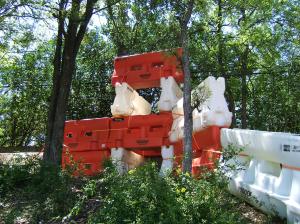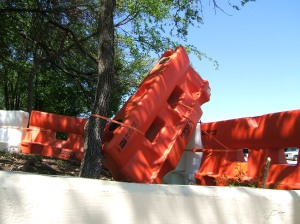Barriers to Thought: Part One
As soon as it was installed almost three weeks ago, a brouhaha brewed in my neighborhood over a temporary sculptural installation on a nearby city right-of-way. The name of the project is “Barton Barriers” and the artist is Stephen Dubov. Here is an overview of the sculpture-among-the-trees:
“Barton Barriers” is the orange-and-white construction barrier ‘snake’ winding through the trees on the rise above the cars. Here is the sign on the Valero gas station parking lot that explains the origin of the work:
The sign informs us that the installation is supported, in part, by the City of Austin Cultural Arts Division and grants from Texas Commission on the Arts and National Endowment for the Arts. It then goes on to list a whole lot of private donors.
Most of the people who posted comments to our neighborhood list serve were unhappy about the new art, and especially unhappy that it was not only ‘ugly’, but that it had been partly supported by public funds. A few people believed the work to be thought-provoking, even whimsical or playful. To put the ‘ugly’ comment into perspective, here are some photos of the adjacent land, as well as views across the street:
I think that it is entirely possible that we are so used to looking at this urban bleakness that we no longer see it for what it is: hideously uninspiring. Prosperous financially, possibly; convenient, definitely; attractive, not even a little bit. In fact, I would not be at all surprised if a comment on this very topic of urban visual malaise is part of what was in the mind of the creator of “Barton Barriers”. That, and the amusing fact that it looks like a giant’s child left playthings under the trees when it was time to go home.
One neighbor praised a number of different “weird south Austin” yard art projects that he enjoys, but specifically stated that “Barton Barriers” lost its charm as soon as money had changed hands and the artist was paid. This neighbor is a doctor, so I wondered if he takes Medicare or Medicaid patients, even though his payment comes from public funds. I also wondered if he refused Medicare patients because his reimbursement for their treatment was too small, as many doctors claim. Somehow an artist is not supposed to be paid by the public, but a doctor is?
The assumptions behind the e-mails ranting against the new art seemed to be: 1) art should be free, or paid for privately; 2) art should be pretty; 3) art should be pleasing to everyone. Not one of these viewpoints is supported historically, but somehow they are rampant in this time and place.
I am sure that there have always been people who create art as a hobby; an activity outside the daily grind of earning bread and shelter. But, there have always been artists who make art for the community and have earned their keep in this way. Even what we call ‘primitive’ cultures have recognized the power and meaning in art and have supported the art-maker as a valued member of the tribe. And no one expected the designer of the Parthenon to work for free, unless a slave, which was a popular work arrangement in the Greece of that time.
If art is integral to a society’s understanding of itself, it follows that in very few cases is art going to be simply pretty for the sake of being pretty. Meaning in life is often unwelcome because it causes us to think uncomfortable thoughts and discover uncomfortable truths about ourselves- never a pretty process.
So, I’m sorry to tell all those folks who don’t like Barton Barriers in the neighborhood, but this sculpture is the result of someone seeing the world in a unique way and inviting the rest of us to travel on our own journeys of discovery. Unless the trip is developed by a travel company to be as hygienic, uneventful, and comfortable as possible, travel invites discomfort, delays, new insights, and an opening of the heart.










Lynn….Thanks for this post…. community art that is controversial art is my favorite…but then……. what community art is not controversial? :o)
Your discussion is thought provoking, and in my mind, when art gets the community involved and interested enough to express their opinions….whether they like the art or not, it is a successful installation!
How eloquently you described your thoughts this piece: “…this sculpture is the result of someone seeing the world in a unique way and inviting the rest of us to travel on our own journeys of discovery”. How nice it would be if we could all think this way, not only when viewing art, but when interacting with our fellow humans!
Thanks for your kind comments, Cynthia! There was only one neighborhood comment which was name-calling and completely insulting to the whole group’s purpose. The rest of the letters were pointed, but not totally rude. My guess is that people are going to kinda miss the old girl when she (the sculpture) is gone! Even all the ones who don’t like it.
I think dialogues similar to those highlighted in your article exist in every single community that goes through the process of installing public art. When our city built a new library, it was radically different from the traditional library architecture and strongly conflicts with the surrounding neighborhood which is much more traditional. It was built more than six years and people still are upset when they look at it. C’est la vie. Great article and thanks for the comment on my article too!
Thanks for reading, Stirling. I just hope people get over being nasty and sarcastic in what is normally a rather liberal neighborhood.